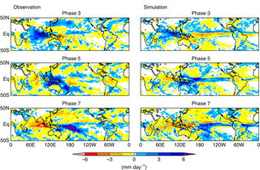Research Abstract
スーパーコンピュータを用いて示された新世代全球モデルにおけるマッデンジュリアン振動の予測スキル
Madden–Julian Oscillation prediction skill of a new-generation global model demonstrated using a supercomputer
2014年5月6日 Nature Communications 5 : 3769 doi: 10.1038/ncomms4769

全球雲/雲システム解像モデルは、マッデンジュリアン振動(MJO)と呼ばれる、熱帯地方の季節内変動において支配的で、かつ全球に影響を与える巨大な東進する大気の脈動をよく予測すると認識されている。しかしながら、数値モデルの複雑さのため、詳細な解析は計算機性能の制約を受ける。本研究では、最近開発されたスーパーコンピュータを用いて一連のシミュレーションを実行した。このスーパーコンピュータのおかげで、膨大な計算機コストを必要とする新世代のモデルにおけるMJOの予測性能の統計的評価が、現業の予報モデルと同じ方法で可能となった。我々は、2003~2012年の期間の全ての冬の時期のMJOの事例を含むシミュレーションを実行して、このモデルの現時点でのMJO予測性能が、27日間であると見積もった。シミュレートされたMJOの位相別の降水分布は、観測とよく一致している。得られた結果は、全球雲解像という手法がMJOの理解と熱帯の1か月予測に有用であることを示している。
宮川 知己1, 佐藤 正樹1,2, 三浦 裕亮1,3, 富田 浩文1,4, 八代 尚4, 野田 暁1, 山田 洋平1, 小玉 知央1, 木本 昌秀2 & 米山 邦夫1
- 海洋研究開発機構
- 東京大学 大気海洋研究所
- 東京大学 理学系研究科
- 理化学研究所 計算科学研究機構
Global cloud/cloud system-resolving models are perceived to perform well in the prediction of the Madden–Julian Oscillation (MJO), a huge eastward -propagating atmospheric pulse that dominates intraseasonal variation of the tropics and affects the entire globe. However, owing to model complexity, detailed analysis is limited by computational power. Here we carry out a simulation series using a recently developed supercomputer, which enables the statistical evaluation of the MJO prediction skill of a costly new-generation model in a manner similar to operational forecast models. We estimate the current MJO predictability of the model as 27 days by conducting simulations including all winter MJO cases identified during 2003–2012. The simulated precipitation patterns associated with different MJO phases compare well with observations. An MJO case captured in a recent intensive observation is also well reproduced. Our results reveal that the global cloud-resolving approach is effective in understanding the MJO and in providing month-long tropical forecasts.

